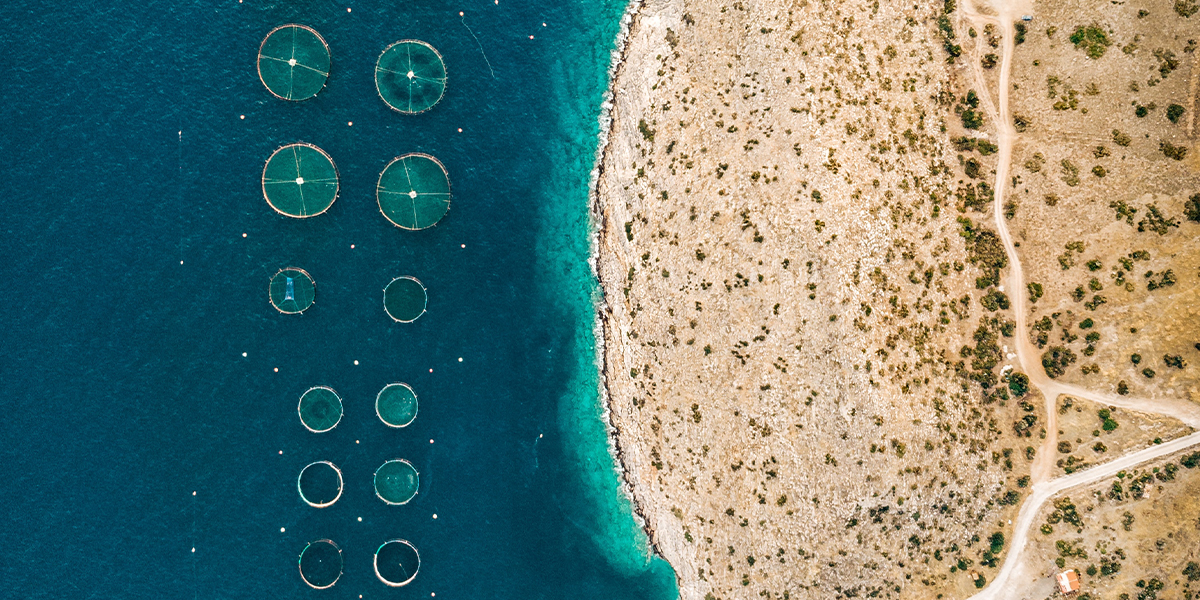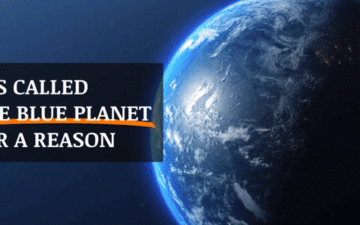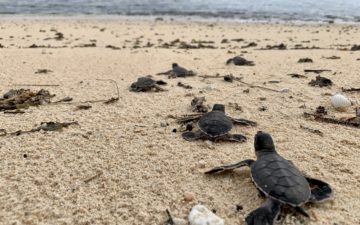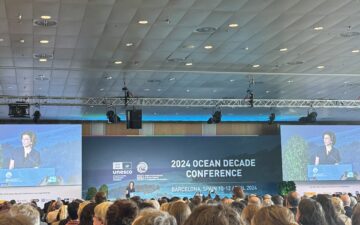Sustainable aquaculture could be the key to feeding our growing population. Currently, 42% of the seafood we consume is farmed, but there are no regulations that constitute what “good” aquaculture is yet.
Aquaculture makes a substantial contribution to our food supplies, so it must be done in a way that is sustainable. Specifically, The OF is looking at various closed-system technologies, including re-circulating tanks, raceways, flow-through systems, and inland ponds. These systems are being used for numerous species of fish, shellfish, and aquatic plants. Although the clear benefits (health and otherwise) of closed-system aquaculture systems have been recognized, we also support efforts to avoid the environmental and food safety flaws of open pen aquaculture. We hope to work toward international as well as domestic efforts that can effect positive change.
The Ocean Foundation has compiled the following outside sources into an annotated bibliography to provide more information on Sustainable Aquaculture for all audiences.
Table of Contents
1. Introduction to Aquaculture
2. The Basics of Aquaculture
3. Pollution and Threats to the Environment
4. Current Developments and New Trends in Aquaculture
5. Aquaculture and Diversity, Equity, Inclusion, and Justice
6. Regulations and Laws Regarding Aquaculture
7. Additional Resources & White Papers Produced by The Ocean Foundation
1. Introduction
Aquaculture is the controlled cultivation or farming of fish, shellfish, and aquatic plants. The purpose is to create a source of aquatic-sourced food and commercial products in a way that will increase availability while reducing environmental harm and protecting various aquatic species. There are several different kinds of aquaculture that each has varying degrees of sustainability.
Rising global populations and income will continue to increase demand for fish. And with wild catch levels essentially flat, all increases in fish and seafood production have come from aquaculture. While aquaculture does face challenges such as sea lice and pollution many players in the industry are actively working to address its challenges.
Aquaculture—Four Approaches
There are four major approaches to aquaculture seen today: near-shore open pens, experimental offshore open pens, land-based “closed” systems, and “ancient” open systems.
1. Near-shore Open Pens.
The near-shore aquaculture systems have most often been used to raise shellfish, salmon and other carnivorous finfish and, except for shellfish mariculture, are typically seen as the least sustainable and the most environmentally detrimental type of aquaculture. The inherent “open to the ecosystem” design of these systems makes it extremely hard to address the problems of fecal waste, interactions with predators, introduction of non-native/exotic species, excess inputs (food, antibiotics), habitat destruction, and disease transfer. In addition, coastal waters cannot sustain the current practice of moving on down the shoreline following disabling disease outbreaks within the pens. [NB: If we grow mollusks near shore, or dramatically limit near-shore open pens in scale and focus on raising herbivores, there is some improvement on the sustainability of the aquaculture system. In our view it is worth exploring these limited alternatives.]
2. Offshore Open Pens.
The newer experimental offshore pen aquaculture systems just move these same negative effects out of sight and also add other impacts on the environment, including the larger carbon footprint to manage facilities that are further offshore.
3. Land-based “Closed” Systems.
Land-based “closed” systems, commonly referred to as recirculating aquaculture systems (RAS), are receiving more and more attention as a viable long-term sustainable solution to aquaculture, both in the developed and developing world. Small, inexpensive closed systems are being modeled to be used in developing countries while larger, more commercially viable, and expensive options are being created in more developed countries. These systems are self-contained and often allow for effective polyculture approaches to raising animals and vegetables together. They are particularly considered sustainable when they are powered by renewable energy, they ensure nearly 100% reclamation of their water, and they are focused on raising omnivores and herbivores.
4. “Ancient” Open Systems.
Fish farming is not new; it has been practiced for centuries in many cultures. Ancient Chinese societies fed silkworm feces and nymphs to carp raised in ponds on silkworm farms, Egyptians farmed tilapia as part of their elaborate irrigation technology, and Hawaiians were able to farm a multitude of species such as milkfish, mullet, prawns, and crab (Costa-Pierce, 1987). Archaeologists have also found evidence for aquaculture in Mayan society and in the traditions of some North American native communities (www.enaca.org).
Environmental Issues
As noted above there are several types of Aquaculture each with their own environmental footprint that vary from sustainable to highly problematic. Offshore aquaculture (often called open ocean or open water aquaculture) is seen as a new source of economic growth, but it ignores a series of environmental and ethical issues of a few companies controlling vast resources through privatization. Offshore aquaculture may lead to the spread of disease, promote unsustainable fish feed practices, cause the discharge of bio-hazardous materials, entangle wildlife, and lead fish escapes. Fish escapes are when farmed fish escape into the environment, which causes significant harm to the wild fish population and the ecosystem as a whole. Historically it has not been a question of if escapes occur, but when they will occur. One recent study found that 92% of all fish escapes are from sea-based fish farms (Føre & Thorvaldsen, 2021). Offshore aquaculture is capital intensive and not financially viable as it currently stands.
There are also issues with waste and wastewater dumping in nearshore aquaculture. In one example nearshore facilities were found to release 66 million gallons of wastewater – including hundreds of pounds of nitrates – into local estuaries every day.
Why should Aquaculture be Encouraged?
Millions of people around the world depend on fish for their food and livelihoods. Roughly one-third of global fish stocks are fished unsustainably, while two-thirds of the ocean’s fish are currently fished sustainably. Aquaculture makes a substantial contribution to our food supplies, so it must be done in a way that is sustainable. Specifically, TOF is looking at various closed-system technologies, including recirculating tanks, raceways, flow-through systems, and inland ponds. These systems are being used for numerous species of fish, shellfish, and aquatic plants. Although the clear benefits (health and otherwise) of closed-system aquaculture systems have been recognized, we also support efforts to avoid the environmental and food safety flaws of open pen aquaculture. We hope to work toward international as well as domestic efforts that can affect positive change.
Despite the challenges of Aquaculture, The Ocean Foundation advocates for the continued development of aquaculture companies – amongst other companies relevant to ocean health – as the world will likely see a rising demand for seafood. In one example, The Ocean Foundation works with Rockefeller and Credit Suisse to speak with aquaculture companies about their efforts to address sea lice, pollution, and the sustainability of fish feed.
The Ocean Foundation is also working in collaboration with partners at the Environmental Law Institute (ELI) and the Harvard Law School’s Emmett Environmental Law and Policy Clinic to clarify and improve how aquaculture is managed in United States federal ocean waters.
Find these resources below and on ELI’s website:
- Offshore Aquaculture Regulation Under the Magnuson-Stevens Fishery Conservation and Management Act (Full Report) (June 2013)
- Offshore Aquaculture Regulation Under the Magnuson-Stevens Fishery Conservation and Management Act (Summary) (June 2013)
- Offshore Aquaculture Regulation Under the Clean Water Act (Full Report) (December 2012)
- Offshore Aquaculture Regulation Under the Clean Water Act (Summary) (December 2012)
- U.S. Army Corps of Engineers Regulation of Offshore Aquaculture (June 2015)FACT SHEET: U.S. Army Corps of Engineers Regulation of Offshore Aquaculture (June 2015)
2. The Basics of Aquaculture
Food and Agriculture Organization of the United Nations. (2022). Fisheries and Aquaculture. United nations. https://www.fao.org/fishery/en/aquaculture
Aquaculture is a millennia-old activity that today supplies more than half of all fish consumed around the world. However, aquaculture has caused undesirable environmental changes including: social conflicts between users of land and aquatic resources, the destruction of important ecosystem services, habitat destruction, the use of harmful chemicals and veterinary drugs, unsustainable production of fishmeal and fish oil, and social and cultural effects on aquaculture workers and communities. This comprehensive overview of Aquaculture for both laymen and experts covers the definition of aquaculture, selected studies, fact sheets, performance indicators, regional reviews, and a code of conduct for fisheries.
Jones, R., Dewey, B., and Seaver, B. (2022, January 28). Aquaculture: Why the World Needs a New Wave of Food Production. World Economic Forum.
https://www.weforum.org/agenda/2022/01/aquaculture-agriculture-food-systems/
Aquatic farmers can be vital observers of changing ecosystems. Marine aquaculture offers numerous benefits from helping the world diversify its stressed food systems, to climate mitigation efforts such as carbon sequestering and contributions to industries that produce eco-friendly products. Aquaculture farmers are even in a special position to act as ecosystem observers and report on environmental changes. The authors acknowledge that aquaculture is not immune to problems and pollution, but once adjustments to practices are made, aquaculture is a critically important industry for long-term sustainable development.
Alice R Jones, Heidi K Alleway, Dominic McAfee, Patrick Reis-Santos, Seth J Theuerkauf, Robert C Jones, Climate-Friendly Seafood: The Potential for Emissions Reduction and Carbon Capture in Marine Aquaculture, BioScience, Volume 72, Issue 2, February 2022, Pages 123–143, https://doi.org/10.1093/biosci/biab126
Aquaculture produces 52% of the aquatic animal products consumed with mariculture generating 37.5% of this production and 97% of the world’s seaweed harvest. However, keeping lower greenhouse gas (GHG) emissions will depend on carefully thought out policies as seaweed aquaculture continues to scale. By linking the provision of mariculture products to GHG abatement opportunities, the authors argue that the aquaculture industry can advance climate-friendly practices that generate sustainable environmental, social, and economic outcomes for the long term.
FAO. 2021. World Food and Agriculture – Statistical Yearbook 2021. Rome. https://doi.org/10.4060/cb4477en
Each year the Food and Agriculture Organization produces a statistical yearbook with information on the global food and agriculture landscape and economically important information. The report includes several sections that discuss data on fisheries and aquaculture, forestry, international commodity prices, and water. While this resource is not as targeted as other sources presented here, its role in tracking the economic development of aquaculture cannot be overlooked.
FAO. 2019. FAO’s work on climate change – Fisheries & aquaculture. Rome. https://www.fao.org/3/ca7166en/ca7166en.pdf
The Food and Agriculture Organisation related a special report to coincide with the 2019 Special Report on the Ocean and Cryosphere. They argue that Climate change will lead to significant changes in the availability and trade of fish and marine products with potentially important geopolitical and economic consequences. This will be particularly hard on countries that depend on the ocean and seafood as a source of protein (fishery-dependent populations).
Bindoff, N.L., W.W.L. Cheung, J.G. Kairo, J. Arístegui, V.A. Guinder, R. Hallberg, N. Hilmi, N. Jiao, M.S. Karim, L. Levin, S. O’Donoghue, S.R. Purca Cuicapusa, B. Rinkevich, T. Suga, A. Tagliabue, and P. Williamson, 2019: Changing Ocean, Marine Ecosystems, and Dependent Communities. In: IPCC Special Report on the Ocean and Cryosphere in a Changing Climate [H.-O. Pörtner, D.C. Roberts, V. Masson-Delmotte, P. Zhai, M. Tignor, E. Poloczanska, K. Mintenbeck, A. Alegría, M. Nicolai, A. Okem, J. Petzold, B. Rama, N.M. Weyer (eds.)]. In press. https://www.ipcc.ch/site/assets/uploads/sites/3/2019/11/09_SROCC_Ch05_FINAL.pdf
Due to climate change, ocean-based extractive industries will not be feasible long-term without adopting more sustainable practices. The 2019 Special Report on the Ocean and Cryosphere notes that the fisheries and aquaculture sector is highly vulnerable to climate drivers. In particular, chapter five of the report argues for increased investment in aquaculture and highlights several areas of research needed to promote long-term sustainability. In short, the need for sustainable aquaculture practices simply cannot be ignored.
Heidi K Alleway, Chris L Gillies, Melanie J Bishop, Rebecca R Gentry, Seth J Theuerkauf, Robert Jones, The Ecosystem Services of Marine Aquaculture: Valuing Benefits to People and Nature, BioScience, Volume 69, Issue 1, January 2019, Pages 59–68, https://doi.org/10.1093/biosci/biy137
As the world’s population continues to grow, Aquaculture will become crucial to the future supply of seafood. However, challenges associated with the negative aspects of aquaculture could impede increased production. The environmental harms will only be mitigated by increasing recognition, understanding, and accounting of ecosystem service provision by mariculture through innovative policies, financing, and certification schemes that may incentivize active delivery of benefits. Thus, aquaculture should be viewed not as separate from the environment but as a crucial part of the ecosystem, as long as proper management practices are put in place.
National Oceanic and Atmospheric Administration (2017). NOAA Aquaculture Research – Story Map. Department of Commerce. https://noaa.maps.arcgis.com/apps/Shortlist/index.html?appid=7b4af1ef0efb425ba35d6f2c8595600f
The National Oceanic and Atmospheric Administration created an interactive story map that highlights their own internal research projects on aquaculture. These projects include analysis of the culture of specific species, life-cycle analysis, alternative feeds, ocean acidification, and potential habitat benefits and impacts. The story map highlights NOAA projects from 2011 through 2016 and is most useful for students, researchers who are interested in past NOAA projects, and a general audience.
Engle, C., McNevin, A., Racine, P., Boyd, C., Paungkaew, D., Viriyatum, R., Quoc Tinh, H., and Ngo Minh, H. (2017, April 3). Economics of Sustainable Intensification of Aquaculture: Evidence from Farms in Vietnam and Thailand. Journal of the World Aquaculture Society, Vol. 48, No. 2, p. 227-239. https://doi.org/10.1111/jwas.12423.
The growth of aquaculture is necessary to provide food for increasing global population levels. This study looked at 40 aquaculture farms in Thailand and 43 in Vietnam to determine how sustainable the growth of aquaculture in these areas is. The study found that there was a strong value when shrimp farmers used natural resources and other inputs in an efficient manner and that on-shore aquaculture can be made to be more sustainable. Additional research will still be needed to provide ongoing guidance related to sustainable management practices for aquaculture.
3. Pollution and Threats to the Environment
Føre, H. and Thorvaldsen, T. (2021, February 15). Causal Analysis of Escape of Atlantic Salmon and Rainbow Trout from Norwegian Fish Farms During 2010 – 2018. Aquaculture, Vol. 532. https://doi.org/10.1016/j.aquaculture.2020.736002
A recent study of Norwegian fish farms found that 92% of all fish escapes are from sea-based fish farms, while less than 7% were from land-based facilities and 1% were from transportation. The study looked at a nine year period (2019-2018) and counted more than 305 reported escaped incidents with nearly 2 million escaped fish, this number is significant given the study was limited to only Salmon and Rainbow Trout farmed in Norway. Most of these escapes were directly caused by holes in the nets, though other technological factors such as damaged equipment and bad weather played a role. This study highlights the significant problem of open water aquaculture as an unsustainable practice.
Racine, P., Marley, A., Froehlich, H., Gaines, S., Ladner, I., MacAdam-Somer, I., and Bradley, D. (2021). A case for seaweed aquaculture inclusion in U.S. nutrient pollution management, Marine Policy, Vol. 129, 2021, 104506, https://doi.org/10.1016/j.marpol.2021.104506.
Seaweed has the potential to reduce marine nutrient pollution, curb growing eutrophication (including hypoxia), and augment land-based pollution control by removing large quantities of nitrogen and phosphorus from coastal ecosystems. Yet, to date very seaweed has not been used in this capacity. As the world continues to suffer from the effects of nutrient runoff, seaweed offers an environmentally friendly solution that is worth the short-term investment for long-term payoffs.
Flegel, T. and Alday-Sanz, V. (2007, July) The Crisis in Asian Shrimp Aquaculture: Current Status and Future Needs. Journal of Applied Ichthyology. Wiley Online Library. https://doi.org/10.1111/j.1439-0426.1998.tb00654.x
In the mid- 2000s, all commonly cultivated shrimp in Asia were found to have White-spot disease causing a likely loss of several billion dollars. While this disease was addressed, this case study highlights the threat of disease within the aquaculture industry. Moving forward further research and development work will be needed, if the shrimp industry is to become sustainable, including: a better understanding of shrimp defenses against disease; additional research into nutrition; and the elimination of environmental harms.
4. Current Developments and New Trends in Aquaculture
Boyd, C., D’Abramo, L., Glencross,B., David C. Huyben, D., Juarez, L., Lockwood, G., McNevin, A., Tacon, A., Teletchea, F., Tomasso Jr, J., Tucker, C., Valenti, W. (2020, June 24). Achieving Sustainable Aquaculture: Historical and current perspectives and future needs and challenges. Journal of the World Aquaculture Society. Wiley Online Libraryhttps://doi.org/10.1111/jwas.12714
Over the last five years, the Aquaculture industry has reduced its carbon footprint through the gradual assimilation of new production systems that have reduced greenhouse gas emissions, reduced the use of freshwater per unit produced, improved feed management practices, and adopted new farming practices. This study proves that while aquaculture continues to see some environmental harm, the overall trend is moving toward a more sustainable industry.
Turchini, G., Jesse T. Trushenski, J., and Glencross, B. (2018, September 15). Thoughts for the Future of Aquaculture Nutrition: Realigning Perspectives to Reflect Contemporary Issues Related to Judicious Use of Marine Resources in Aquafeeds. American Fisheries Society. https://doi.org/10.1002/naaq.10067 https://afspubs.onlinelibrary.wiley.com/doi/full/10.1002/naaq.10067
Over the last several decades’ researchers have made great progress in aquaculture nutrition research and alternative feedstocks. However, reliance on marine resources remains an ongoing constraint that reduces sustainability. A holistic research strategy—aligned with industry needs and focused on nutrient composition and ingredient complementarity—is needed to spur future advancement in aquaculture nutrition.
Buck, B., Troell, M., Krause, G., Angel, D., Grote, B., and Chopin, T. ( 2018, May 15). State of the Art and Challenges for Offshore Integrated Multi-Trophic Aquaculture (IMTA). Frontiers in Marine Science. https://doi.org/10.3389/fmars.2018.00165
The authors of this paper argue that moving aquaculture facilities out to the open ocean and away from nearshore ecosystems will help the large-scale expansion of marine food production. This study excels in its summary of the current developments of offshore aquaculture technologies, especially the use of integrated multi-trophic aquaculture where several species (such as finfish, oysters, sea cucumbers, and kelp) are farmed together to create an integrated cultivation system. However, it should be noted that offshore aquaculture may still cause environmental harm and is not yet economically viable.
Duarte, C., Wu, J., Xiao, X., Bruhn, A., Krause-Jensen, D. (2017). Can Seaweed Farming Play a Role in Climate Change Mitigation and Adaptation? Frontiers in Marine Science, Vol. 4. https://doi.org/10.3389/fmars.2017.00100
Seaweed aquaculture is not only the fastest-growing component of global food production but an industry that is able to help climate change mitigation and adaptation measures. Seaweed aquaculture can act as a carbon sink for biofuel production, improve soil quality by acting as a substitute to more polluting synthetic fertilizer, and dampen wave energy to protect shorelines. However, the current seaweed aquaculture industry is limited by the availability of suitable areas and competition for suitable areas with other uses, engineering systems capable of coping with rough conditions offshore, and increasing market demand for seaweed products, among other factors.
5. Aquaculture and Diversity, Equity, Inclusion, and Justice
FAO. 2018. The State of World Fisheries and Aquaculture 2018 – Meeting the sustainable development goals. Rome. License: CC BY-NC-SA 3.0 IGO. http://www.fao.org/3/i9540en/i9540en.pdf
The United Nations’ 2030 Agenda for Sustainable Development and the Sustainable Development Goals allows for an analysis of fisheries and aquaculture that focuses on food security, nutrition, sustainable use of natural resources, and takes into account economic, social, and environmental realities. While the report is now almost five years old, its focus on rights-based governance for equitable and inclusive development is still highly relevant today.
6. Regulations and Laws Regarding Aquaculture
National Oceanic and Atmospheric Administration. (2022). Guide to Permitting Marine Aquaculture in the United States. Department of Commerce, National Oceanic and Atmospheric Administration. https://media.fisheries.noaa.gov/2022-02/Guide-Permitting-Marine-Aquaculture-United-States-2022.pdf
The National Oceanic and Atmospheric Administration developed a guide for those interested in the United State’s aquaculture policies and permitting. This guide is intended for individuals interested in applying for aquaculture permits and those who want to learn more about the permitting process including key application materials. While the document is not comprehensive, it includes a list of state-by-state permitting policies for shellfish, finfish, and seaweed.
Executive Office of the President. (2020, May 7). U. S. Executive Order 13921, Promoting American Seafood Competitiveness and Economic Growth.
In early 2020, President Biden signed E.O. 13921 of May 7, 2020, to revitalize the U.S. fishing industry. Notably, Section 6 sets out three criteria for aquaculture permitting:
- located within the EEZ and outside of the waters of any State or Territory,
- require environmental review or authorization by two or more (federal) agencies, and
- the agency that would otherwise be the lead agency has determined that it will prepare an environmental impact statement (EIS).
These criteria are intended to promote a more competitive seafood industry within the United States, put safe and healthy food on American tables, and contribute to the American economy. This executive order also addresses the problems with illegal, unreported, and unregulated fishing, and improves transparency.
FAO. 2017. Climate Smart Agriculture Sourcebook – Climate-Smart Fisheries and Aquaculture. Rome.http://www.fao.org/climate-smart-agriculture-sourcebook/production-resources/module-b4-fisheries/b4-overview/en/
The Food and Agriculture Organization has created a sourcebook to “further elaborate the concept of climate-smart agriculture” including both its potential and limitations for dealing with the effects of climate change. This source would be most useful for policymakers at both the national and sub-national levels.
NATIONAL AQUACULTURE ACT OF 1980 Act of September 26, 1980, Public Law 96-362, 94 Stat. 1198, 16 U.S.C. 2801, et seq. https://www.agriculture.senate.gov/imo/media/doc/National%20Aquaculture%20Act%20Of%201980.pdf
Many of the United States’ policies regarding Aquaculture can be traced back to the National Aquaculture Act of 1980. This law required the Department of Agriculture, Department of Commerce, the Department of the Interior, and Regional Fishery Management Councils to establish a National Aquaculture Development Plan. The law called for the plan to identify aquatic species with potential commercial uses, set out recommended actions to be taken by both private and public actors to promote aquaculture and research the effects of aquaculture on estuarine and marine ecosystems. It also created the Interagency Working Group on Aquaculture as the institutional structure to allow for coordination among U.S. federal agencies on aquaculture-related activities. The newest version of the plan, the National Strategic Plan for Federal Aquaculture Research (2014-2019), was created by the National Science and Technology Council Committee on Science Interagency Working Group on Aquaculture.
7. Additional Resources
The National Oceanic and Atmospheric Administration created several fact sheets focused on various aspects of Aquaculture in the United State. Factsheets relevant to this Research Page include: Aquaculture and Environmental Interactions, Aquaculture Provides Beneficial Ecosystem Services, Climate Resilience and Aquaculture, Disaster Assistance for Fisheries, Marine Aquaculture in the U.S., Potential Risks of Aquaculture Escapes, Regulation of Marine Aquaculture, and Sustainable Aquaculture Feeds and Fish Nutrition.
White Papers by The Ocean Foundation:
- Why Aquaculture?
- Aquaculture and Development
- Recirculating Aquaculture Systems
- International Sustainable Aquaculture Strategy
- Sustainable Ancient Aquaculture
- The State of World Fisheries and Aquaculture







